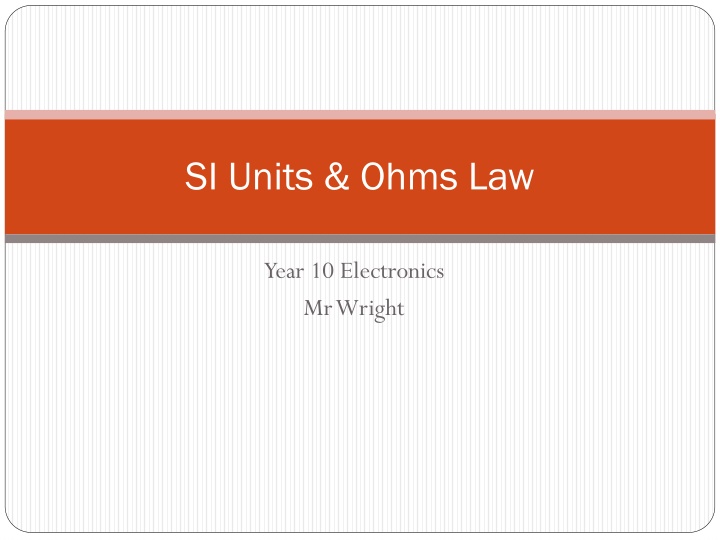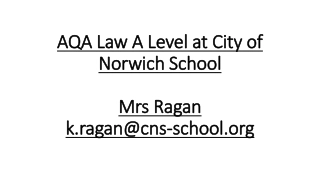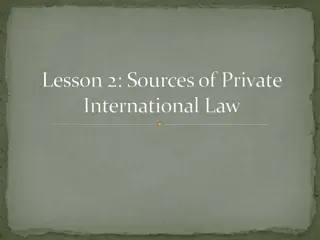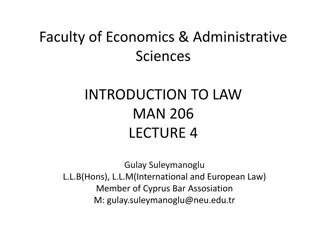
Ohm's Law and SI Units in Electronics
Explore the fundamentals of Ohm's Law, including voltage, current, resistance, and practical exercises. Discover the importance of SI units and prefix multipliers in electronic circuits. Learn how to apply Ohm's Law to calculate voltage, current, and resistance in various scenarios.
Download Presentation

Please find below an Image/Link to download the presentation.
The content on the website is provided AS IS for your information and personal use only. It may not be sold, licensed, or shared on other websites without obtaining consent from the author. If you encounter any issues during the download, it is possible that the publisher has removed the file from their server.
You are allowed to download the files provided on this website for personal or commercial use, subject to the condition that they are used lawfully. All files are the property of their respective owners.
The content on the website is provided AS IS for your information and personal use only. It may not be sold, licensed, or shared on other websites without obtaining consent from the author.
E N D
Presentation Transcript
SI Units & Ohms Law Year 10 Electronics Mr Wright
Prefix Multipliers 1012 1 Tera (T) 1,000,000,000,000 1 Giga (G) 109 1,000,000,000 1 Mega (M) 106 1,000,000 103 1 Kilo(K) 1,000 1 0.001 10-3 1 milli (m) 1 micro ( ) 10-6 1 nano (n) 1 pico (p) 0.000001 0.000000001 0.000000000001 10-9 10-12
SI Units Voltage Current Resistance Capacitance Time Frequency Power Charge Energy Volts Amps Ohms Farads Seconds Hertz Watts Colombs Joules
Ohms Law The most important equation you will ever learn in electronics V = IR V = voltage (Volts) I = current (Amps) R = resistance (Ohms) V I R
V Some Exercizes I R What voltage must be applied to a 2k resistor in order for a 10mA current to flow ? A coil has a current of 50 mA flowing through it when the voltage is 12 V. What is the resistance of the coil? A 100 V battery is connected across a resistor and causes a current of 5mA to flow. Determine the resistance of the resistor.
What Else Does Ohms Law Tell us? Rule 1: A resistor with a current flowing through it will always have a voltage drop across it Example The light bulb demands 50mA In the left hand circuit it has 9V across it & its demand is met +9V +9V If I insert a 220 resistor in series with the light bulb : 1. What current flows through the resistor ? 2. What current flows through the light bulb 3. what voltage does the light bulb see now R = 220 X 50mA X 50mA 0V 0V
V Rule 1: Example 2 I R The LED will blow up if it sees more than 15mA The LED has a voltage drop of 1.5V The power supply is +5v So what happens to the other 3.5V ? What is the value of the resistor ?
V Rule 2: I R A current cant exist without a voltage I = V/R If V = 0, then the value of R is irrelevant I will always = 0 (NOTHING DIVIDED BY SOMETHING IS ALWAYS NOTHING) So if any part of your circuit cant see a voltage it wont work !
V Rule 3: I R The higher the resistance, the lower the current Resistors limit current
V Rule 4: I R The lower the resistance the lower the voltage drop
Potential Dividers Potential Divider Simulator The fact that resistors drop voltage across them can be used to create fractions of the supply voltage Vs R1 R2 Vo 0V
Why Might I Want One ? (What use are they ?) If I have 9v supply (for example): I might want 5v to drive part of my chip I might want just 1v to drive a transistor I could use a second supply at a different voltage but deriving a lower voltage from the primary supply is more efficient
Example 1 Resistors R1 & R2 are equal Each will drop the same amount of voltage The voltage seen at the output is exactly half the supply
Example 2 R2 is 2x bigger than R1 R2 will drop 2x more voltage than R1 The voltage seen at the output is 2/3 of supply
Its all about ratios ! Vo = Vs R2 / (R1 + R2) If supply voltage = 9V and R1 =2k and R2 = 1k, R2 will drop half as much voltage as R1 The voltage seen at the output is 3v If supply = 12V and R1 =2K and R2=1k, the output voltage will be ????
Remember The bigger the resistor, the bigger the voltage drop Output voltage is always measured between 0V and the connection point of R1 & R2 What is difference between: A: supply = 9V, R1 = 1K, R2=2K B: supply = 9V, R1 = 100 , R2 = 200
Other ways of controlling voltage The zener diode This conducts only when the voltage accross it reaches a certain voltage
P DC Average Power I V How much energy is transferred in a unit of time Burned or generated Measured in Watts Average power: P= IV Things that affect how much power a circuit will use: Supply voltage Amount of time it is switched on for Activity (amount of switching)
Why Is Power Important ? Burning energy generates heat If I have a resistor with 9V across it and 100mA flowing through it, I will burn 0.9 W Resistors come in different power ratings Higher values are: Physically bigger Can dissipate more heat Cost a lot more If your resistor cant handle the power of your circuit, it will melt & fail Most resistors in school are 0.25W, 0.5W or 0.6W Metal film / carbon Higher values (1W, 5W etc) are available Wire wound






















